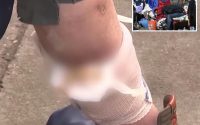Gilgo Beach killer shook community for 13 years after 911 call sparked grisly discovery
The tight-knit community of Gilgo Beach on Long Island changed forever with one chilling 911 call placed on May 10, 2010.
“Something is going to happen to me … there’s somebody after me… please,” 24-year-old sex worker Shannan Gilbert told a dispatcher in a chaotic 911 call.
The sex worker from Jersey City, NJ, who met her clients through Craigslist, vanished after leaving a client’s home on foot in the seafront community of Oak Beach and disappearing into the marshes.
The search for her ended eight months later but set into motion a much more grizzly mystery that would terrorize Long Island and cast a shadow over the community for more than a decade, with 10 bodies found in the area.
On Dec. 11, 2010, a Suffolk County cop and cadaver dog were scouring a dense shrub area along the Ocean Parkway at Gilgo Beach in search of Gilbert’s body when they made the grim discovery of another woman’s remains.
That body was later identified as 24-year-old Melissa Barthelemy – a sex worker who was last seen more than 18 months earlier in the Big Apple.
Then, over the next two days, the remains of three other women — Megan Waterman, 22, Amber Costello, 27, and Maureen Brainard-Barnes, 25 – were quickly discovered buried about one-tenth of a mile apart from each other on the beach.

Fears of a serial killer were quickly sparked when it was determined that the four women, who cops said were all Craigslist escorts, had been killed and a similar fashion and found wrapped in a burlap sack.
The women – dubbed by investigators as the “Gilgo Four” – had last been seen between July 2007 and September 2010, cops said.
As the search for Gilbert continued, the number of human remains uncovered near Gilgo Beach climbed to 10 – those of eight women, one man and a toddler – by spring 2011.
Who is Gilgo Beach serial killer suspect Rex Heuermann?
A suspected serial killer has been arrested over the notorious Gilgo Beach murders in Long Island, The Post can confirm.
Rex Heuermann, 59, a married dad of two and architect at a New York City firm, has a home on 1st Avenue in Massapequa Park, sources told The Post.

His arrest is tied to the “Gilgo Four,” four women — Melissa Barthelemy, 24, Megan Waterman, 22, Amber Lynn Costello, 27, and Maureen Brainard-Barnes, 25 — found wrapped in burlap within days of each other in 2010.
The body of Barthelemy was first found along Ocean Parkway on Dec. 11, 2010, sparking fears of a serial killer in the area.
By spring 2011, the number of bodies had climbed to 10, including eight women as well as an unidentified man and toddler.
Heuermann’s arrest comes after Suffolk County’s new police commissioner created a special Gilgo Beach Homicide Investigation Task Force in February 2022.
Follow the Post’s Live blog for updates
Gilbert’s body wasn’t recovered until December 2011, about 3 miles east of where the other 10 sets were discovered.
In the wake of the grim discoveries, investigators spent the next few years flip-flopping on whether the 11 slain were murdered at the hands of the same sick killer.’
The reaction to the murders also caused controversy with the police accused of not putting as much effort into the probe as possible because the girls were all prostitutes.

Authorities had initially suspected that the majority of the deaths weren’t all linked because of the number of victims and the fact that some were dismembered and some were intact.
But the Suffolk County Police Commissioner at the time, Richard Dormer, came out publicly in December 2011 to say they were working off the theory that one serial killer was to blame.
Follow The Post’s live blog for updates on the Gilgo Beach serial killings arrest
He argued that it wasn’t unusual for a serial killer to evolve and adjust their methods over time, but he conceded that others – including some in his own department – disagreed.
Authorities later said they thought Gilbert’s death was an “unfortunate accident” and she had possibly drowned in the marsh where her body was found. They determined, however, that the deaths of the Gilgo Four were probably the work of one person.

The probe into the high-profile case started to go cold through 2012. Frustrated FBI sources claimed Suffolk brass were unwilling to let the feds help in the otherwise-stalled investigation.
In 2015, the local agency did an about-turn and asked the feds to take on a prime role in the probe.

Still, it wasn’t until 2020 when then-Suffolk commish, Geraldine Hart, announced efforts to advance the case, including the launch of the GilgoNews website which accepted anonymous tips.
Investigators also released a string of photos of a leather belt they believed belonged to the suspect, which was embossed with the letters “HM” or “WH” and had been collected early on in the probe.
“We do believe that the belt was handled by the suspect, and did not belong to any of the victims,” Hart said.

Then, last year, newly appointed Commissioner Rodney Harrison formed an interagency task force investigators from the FBI, as well as state and local police departments, aimed at solving the case.
“I believe this case is solvable and identifying the person or people responsible for these murders is a top priority,” he said at the time.
A re-examining of the evidence led officials to Rex Heuermann, who fitted the exact profile of the killer composed in 2011 which they had been looking for.
It also appears he had been hiding in plain sight, with the veneer of respectability working as an architect in the city and being a family man afforded in.
Now he stands accused of killing at least three of the young women hastily buried on Gilgo beach and police announced Friday they have evidence he was not only trawling for sex and watching unspeakable pornography online, but that they feared the very worst – that he would soon kill again.


